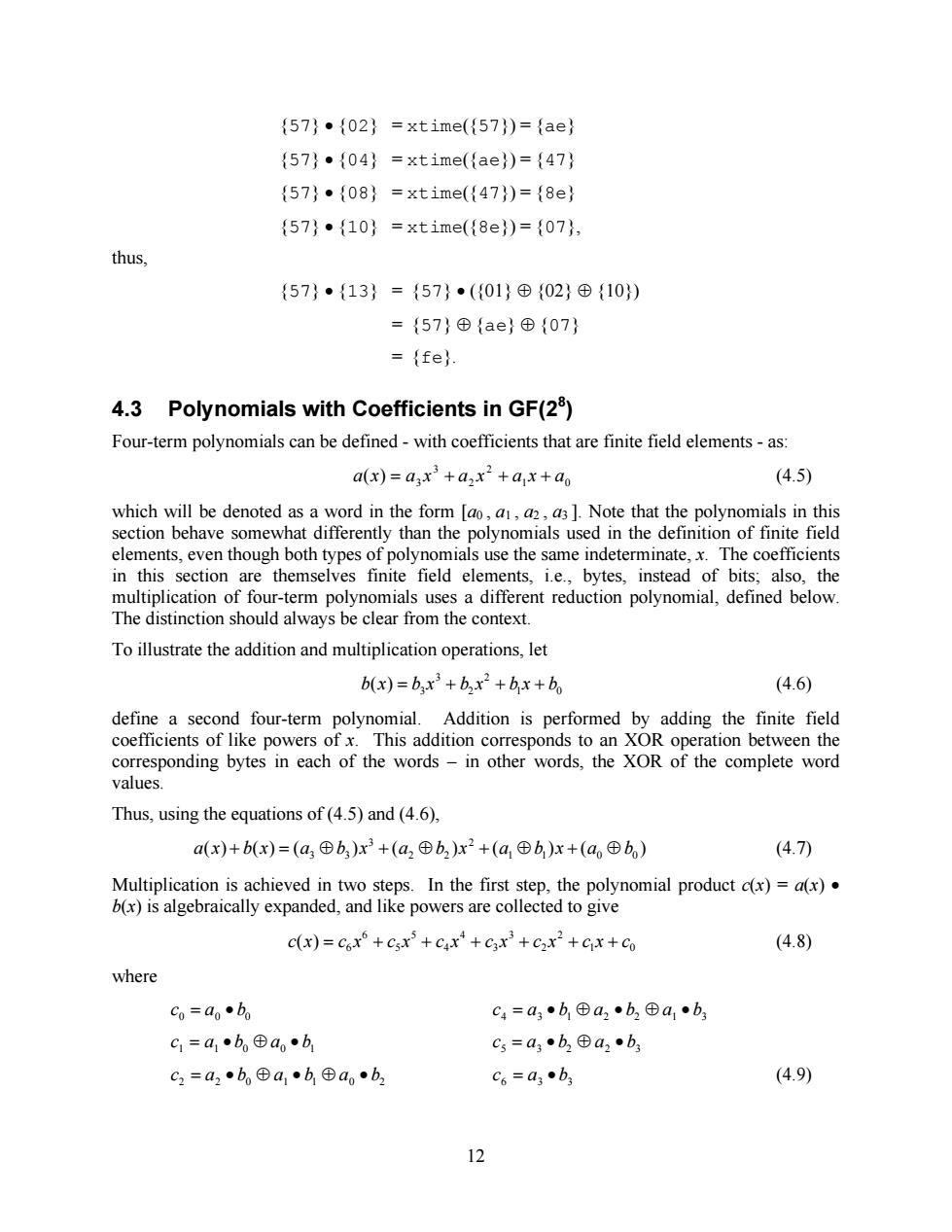正在加载图片...

{57}·{02}=xtime({57})={ae} {57}·{04}=xtime({ae})={47} {57}·{08}=xtime({47})={8e} {57}·{10}=xtime({8e})={07}, thus, {57}·{13}={57}·({01}⊕{02}⊕{10}) ={57}⊕{ae}⊕{07} ={fe}. 4.3 Polynomials with Coefficients in GF(2) Four-term polynomials can be defined-with coefficients that are finite field elements-as: a(x)=ax+ax2+ax+ao (4.5) which will be denoted as a word in the form [ao,a,2,as].Note that the polynomials in this section behave somewhat differently than the polynomials used in the definition of finite field elements,even though both types of polynomials use the same indeterminate,x.The coefficients in this section are themselves finite field elements,i.e.,bytes,instead of bits;also,the multiplication of four-term polynomials uses a different reduction polynomial,defined below. The distinction should always be clear from the context. To illustrate the addition and multiplication operations,let b(x)=bx3+b2x2+bx+b。 (4.6) define a second four-term polynomial.Addition is performed by adding the finite field coefficients of like powers of x.This addition corresponds to an XOR operation between the corresponding bytes in each of the words -in other words,the XOR of the complete word values. Thus,using the equations of(4.5)and(4.6), a(x)+b(x)=(a3⊕b)x3+(a2田b2)x2+(a1⊕b)x+(a⊕b) (4.7) Multiplication is achieved in two steps.In the first step,the polynomial product c(x)=a(x). b(x)is algebraically expanded,and like powers are collected to give c(x)=Cox+csx+cax+cx+czx2+cx+co (4.8) where co=a·b C4=a3·b⊕a2·b2⊕a1·b3 C1=a1·b⊕a·b C5=a3·b2©a2·b3 C2=a2b⊕a1b⊕a·b2 C6=a3·b (4.9) 1212 {57} · {02} = xtime({57}) = {ae} {57} · {04} = xtime({ae}) = {47} {57} · {08} = xtime({47}) = {8e} {57} · {10} = xtime({8e}) = {07}, thus, {57} · {13} = {57} · ({01} Å {02} Å {10}) = {57} Å {ae} Å {07} = {fe}. 4.3 Polynomials with Coefficients in GF(28 ) Four-term polynomials can be defined - with coefficients that are finite field elements - as: 1 0 2 2 3 3 a(x) = a x + a x + a x + a (4.5) which will be denoted as a word in the form [a0 , a1 , a2 , a3 ]. Note that the polynomials in this section behave somewhat differently than the polynomials used in the definition of finite field elements, even though both types of polynomials use the same indeterminate, x. The coefficients in this section are themselves finite field elements, i.e., bytes, instead of bits; also, the multiplication of four-term polynomials uses a different reduction polynomial, defined below. The distinction should always be clear from the context. To illustrate the addition and multiplication operations, let 1 0 2 2 3 3 b(x) = b x + b x + b x + b (4.6) define a second four-term polynomial. Addition is performed by adding the finite field coefficients of like powers of x. This addition corresponds to an XOR operation between the corresponding bytes in each of the words – in other words, the XOR of the complete word values. Thus, using the equations of (4.5) and (4.6), ( ) ( ) ( ) ( ) ( ) ( ) 1 1 0 0 2 2 2 3 a x + b x = a3 Åb3 x + a Åb x + a Åb x + a Åb (4.7) Multiplication is achieved in two steps. In the first step, the polynomial product c(x) = a(x) · b(x) is algebraically expanded, and like powers are collected to give 1 0 2 2 3 3 4 4 5 5 6 6 c(x) = c x + c x + c x + c x + c x + c x + c (4.8) where 0 a0 b0 c = · 4 a3 b1 a2 b2 a1 b3 c = · Å · Å · 1 a1 b0 a0 b1 c = · Å · 5 a3 b2 a2 b3 c = · Å · 2 a2 b0 a1 b1 a0 b2 c = · Å · Å · 6 a3 b3 c = · (4.9)